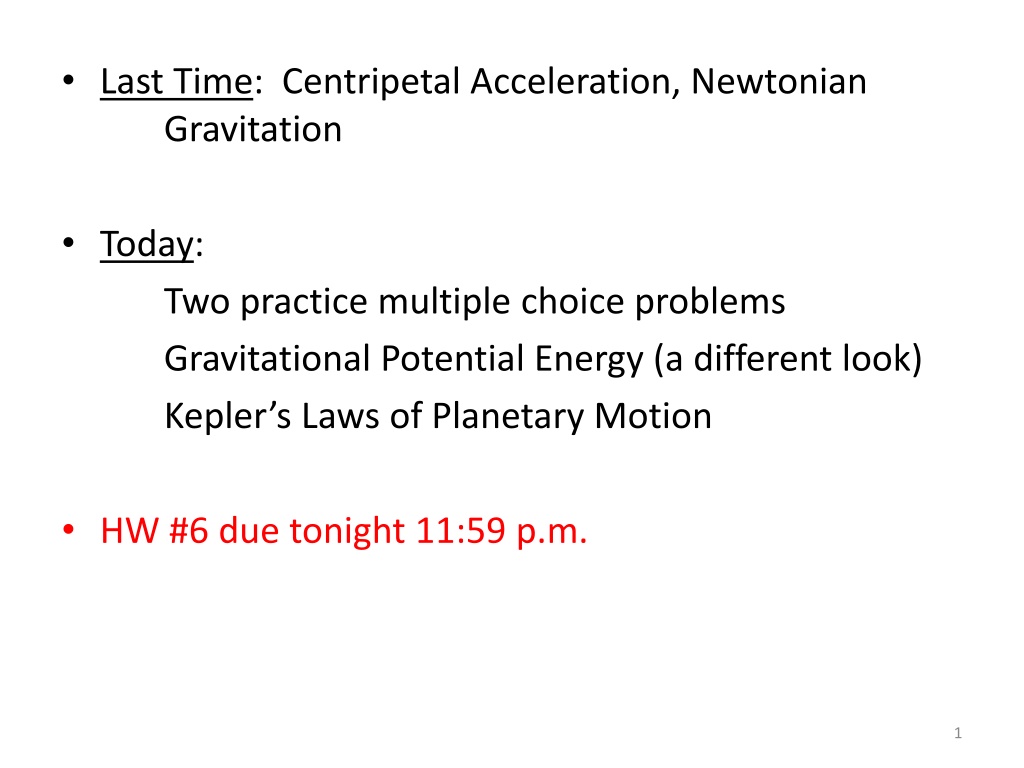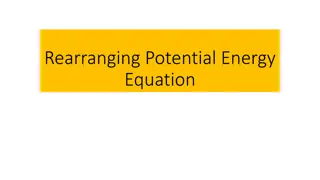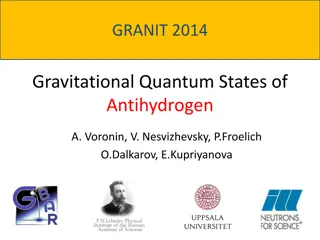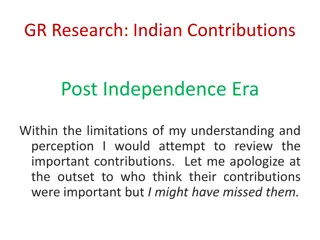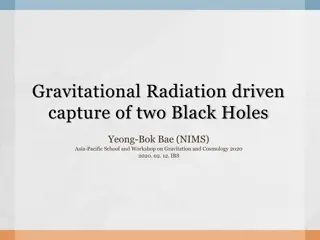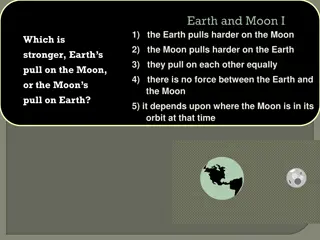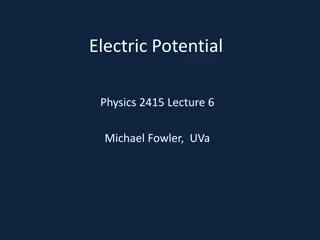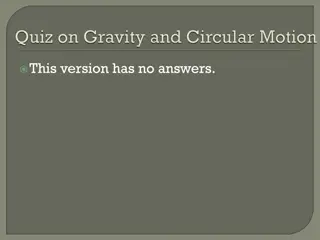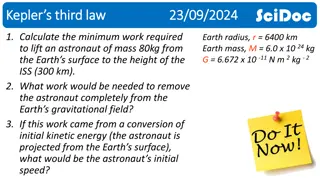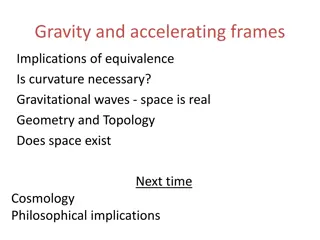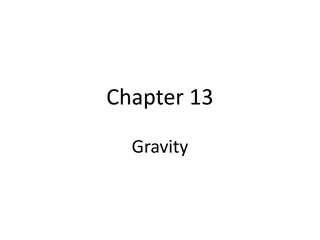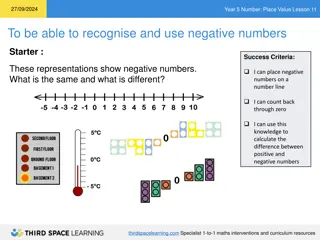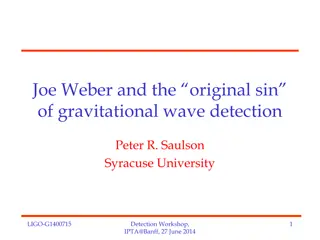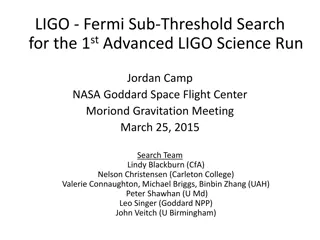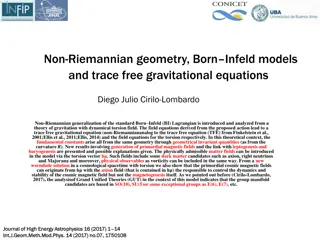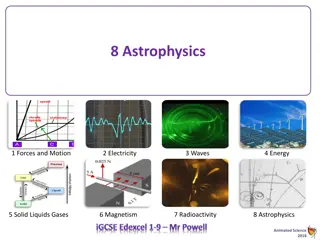Understanding Gravitational Potential Energy and Negative Potential Energy
Exploring the concept of gravitational potential energy beyond the surface of Earth, understanding how potential energy varies with distance from the Earth's center, and delving into the significance of negative potential energy at certain points. Learn about the calculations involved, including the equation for gravitational potential energy and its implications for objects at different distances from Earth.
- Gravitational Potential Energy
- Negative Potential Energy
- Distance from Earth
- Energy Calculations
- Earths Surface
Download Presentation

Please find below an Image/Link to download the presentation.
The content on the website is provided AS IS for your information and personal use only. It may not be sold, licensed, or shared on other websites without obtaining consent from the author. Download presentation by click this link. If you encounter any issues during the download, it is possible that the publisher has removed the file from their server.
E N D
Presentation Transcript
Last Time: Centripetal Acceleration, Newtonian Gravitation Today: Two practice multiple choice problems Gravitational Potential Energy (a different look) Kepler s Laws of Planetary Motion HW #6 due tonight 11:59 p.m. 1
Exam #2 Details : Thursday, October 21, regular class time (75 minutes) Closed-book, closed-note You CAN AND SHOULD bring a calculator Exam #2 Formula Sheet posted on Blackboard Will be provided (not allowed to bring your own copy) Today s new material NOT on the exam Multiple Choice: 5 5 points = 25 points Short Answer(s): 10 points Problems: 3 problems, 65 points Bonus Problem: 5 points Possible Total: 105/100 2
Typo Last Time G = 6.673 10 11 kg 1 m3 s 1 should be G = 6.673 10 11 kg 1 m3 s 2 3
Conceptual Question #1 (practice for exam) A merry-go-round rotates with constant angular speed. As a rider moves from the edge towards the center, what happens to the magnitude of the centripetal force that must be exerted on her ? Mall of America (Minneapolis, MN) (a) It increases. (b) It is not zero, but remains the same. (c) It decreases. (d) It is always zero, because its angular speed is constant. (e) It increases or decreases, depending on the direction of rotation (CCW or CW). 4
Conceptual Question #2 (practice for exam) The gravitational force exerted on an astronaut on Earth s surface before launch is 650 N downwards. On the International Space Station, is the gravitational force on the astronaut (a) Larger (b) Exactly the same (c) Smaller (d) Zero 5
Gravitational Potential Energy So far, we have calculated the potential energy of an object above the Earth s surface as : PE = m g h m g h force distance But, we learned that the acceleration due to gravity decreases the farther we move away from the surface of the Earth. mg F high above the Earth ! For objects high above the Earth, the gravitational potential energy associated with a mass m at a distance r from the center of the Earth is m M G PE = ME : Earth s mass [ SI: Joules ] E r 6
Negative Potential Energy ? PE = 0 at r PE is a MAXIMUM at r For r < , PE < 0, becomes more negative as move towards Earth M m = E PE G r Consider an object with a mass of 1.0-kg falling towards Earth, which is initially 2 106 m above the surface of Earth at rest. What is its speed when it is 1 106 m above the Earth ? 106 m 106 m RE How much work was done by gravity ? ME 7
What About PE = mgh ? Is our new formula for gravitational PE consistent with PE = mgh on the surface of the Earth ? M m + = #2 E PE G 2 ( ) R h E M m = E PE G 1 R h E 1 1 GM mh ) = GM = E PE PE m 2 1 E + + ( R h R R h R #1 E E E E Earth s surface 1 1 GM = = E PE PE m h mgh 2 1 + 2 2 E ( ) R R h R R E E E 8
What Must the Speed of a Rocket be to Escape Earth s Gravity ? The escape speed of a rocket is the speed with which a rocket needs to be launched, in order to escape Earth s gravity, and reach . At : At launch: Energy Conservation : 1 M m M m = = = 0 2 esc PE 0 E E PE G mv G 2 R R E E 1mv KE = 2 esc = 0 11.2 km/s on Earth [25054 mph] KE barely makes it to GM 2 2 esc= E v R E 9
Example A space capsule with mass 1000 kg is launched from the surface of Earth at the escape speed vesc. What will its speed be when it is 103 km above the surface of the Earth ? 10
Keplers Laws of Planetary Motion German mathematician and astronomer, 1571 1630 Work provided the grounds for Newton s theory of gravitation Before Kepler sLaws Geocentric Model : Earth is center of universe Greek astronomer Ptolemy, 2nd century A.D. 1400s Heliocentric Model : Earth/Planets orbit Sun in circular orbits Copernicus, 1473 1543 Kepler analyzed data for 16 years, and deduced a mathematical model for the motion of planets about the Sun 11
Keplers Laws of Planetary Motion All planets move in elliptical orbits about the Sun (not circular orbits), with the Sun at one of the focal points. #1 Ellipse is a curve drawn so that the sum of the distances from any point on the curve, to two internal points called the focal points, is constant. p + q = constant [for any point on the ellipse] Because orbit is an ellipse, the Planet s distance from the Sun is constantly changing ! 12
Keplers Laws of Planetary Motion A line drawn from the Sun to any planet sweeps out equal areas in equal time intervals. #2 According to this law, the if the areas above are equal, the planet will take the same amount of time to move from A B as it does to move from C D. Planets move faster the closer they are to the Sun ! [Also follows from conservation of angular momentum, later ] 13
Keplers Laws of Planetary Motion 2a r For circular orbits, the square of the orbital period of any Planet (or a satellite) is proportional to the cube of the average distance from the Planet to the Sun. #3 MS: mass of the Sun = 1.991 1030 kg OR the object about which it is orbiting 2 4 S = 2 3 T r GM r : radius of circular orbit Period T = time required for one revolution = 2 r/v For elliptical orbits, r must be replaced with a, the semimajor axis (half the longest distance). 14
Example A satellite moves in a circular orbit around the Earth at a speed of 5000 m/s. Determine: (a) The satellite s altitude above the surface of the Earth. (b) The period of the satellite s orbit. 15
Geosynchronous Orbits A satellite in a geosynchronous orbit remains at the same location relative to a location on the Earth. These are used in telecommunications. This can only occur if the satellite s orbital period is the same as the Earth s period of rotation, 24.0 hours. (a) At what distance from the center of the Earth must the satellite be? (b) What is the satellite s orbital speed? 16
Next Lecture Class 8.1 8.2 : Torque and Equilibrium 17
